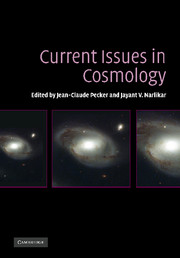Book contents
- Frontmatter
- Contents
- List of contributors
- Preface
- Part I Observational facts relating to discrete sources
- Part II Observational facts relating to background radiation
- Part III Standard cosmology
- 7 Cosmology, an overview of the standard model
- 8 What are the building blocks of our Universe?
- Part IV Large-scale structure
- Part V Alternative cosmologies
- Part VI Evidence for anomalous redshifts
- Part VII Panel discussion
- Index
8 - What are the building blocks of our Universe?
Published online by Cambridge University Press: 15 December 2009
- Frontmatter
- Contents
- List of contributors
- Preface
- Part I Observational facts relating to discrete sources
- Part II Observational facts relating to background radiation
- Part III Standard cosmology
- 7 Cosmology, an overview of the standard model
- 8 What are the building blocks of our Universe?
- Part IV Large-scale structure
- Part V Alternative cosmologies
- Part VI Evidence for anomalous redshifts
- Part VII Panel discussion
- Index
Summary
Abstract
We are told that we are living in a Golden Age of Astronomy. Cosmological parameters are found with unprecedented accuracy. Yet, the known form of matter forms only a small fraction of the total energy density of the Universe. Also, a mysterious dark energy dominates the Universe and causes acceleration in the rate of expansion.
Introductory remarks
We live in an exciting age of astronomy. Some thirty years ago, cosmology was a science of only two parameters, the current expansion rate or the Hubble constant, H0, and its change over time or the deceleration parameter, q0. Questions such as the age of the Universe, its large- and small-scale structure, origin of galaxies, and the formation of stars were considered as speculative with no direct connection to precise measurements. The situation has changed drastically with the discoveries of giant walls of galaxies, voids, dark matter on the one hand, and on the other hand, the tiny variations in the cosmic background radiation and a “mysterious” uniformly distributed, diffuse dark energy causing acceleration of the expansion rate of the Universe. There are some sixteen cosmological parameters whose measured values exhibit unprecedented accuracy in the history of astronomy. Ten of these parameters are “global” in the sense that they pertain to the idealized standard model of a homogeneous isotropic universe governed by the Friedmann–Lemetre– Walker–Robertson metric within the framework of general relativity. The other six refer to more details of the model, to the deviations from homogeneity and their manifestations in the cosmic structure.
- Type
- Chapter
- Information
- Current Issues in Cosmology , pp. 101 - 108Publisher: Cambridge University PressPrint publication year: 2006



